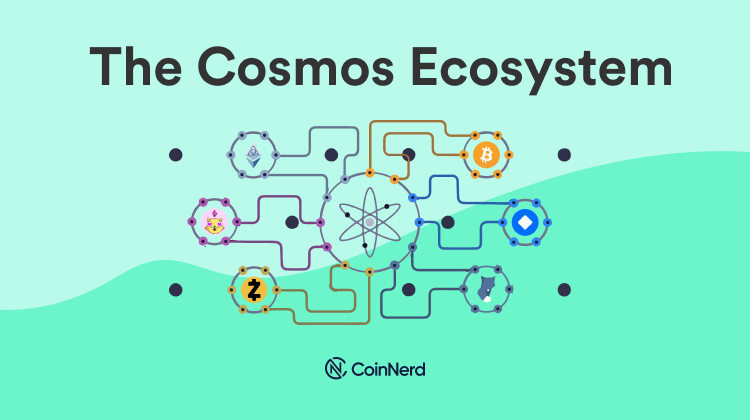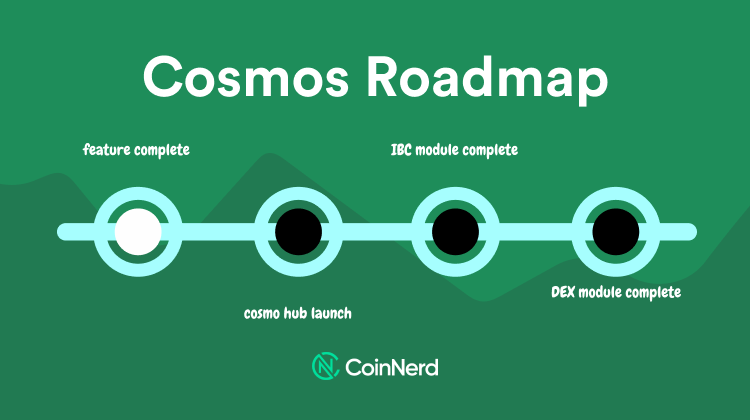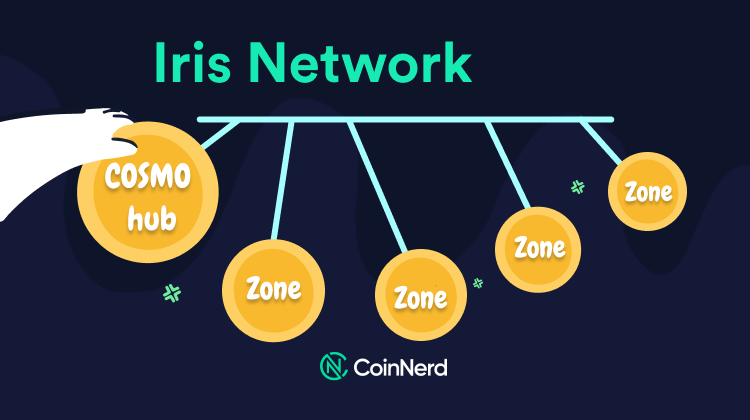What is Cosmo? An In-Depth Guide about the Cosmo Ecosystem
Cosmos Blockchain Overview
Layer-1 Blockchains, such as Solana, Near, Avalanche, Fantom, etc., are receiving a lot of attention recently. Is the “Internet of Blockchains” platform worth paying attention to, or is it a waste of time?
What is Cosmo? What is the Atom Coin? If you want to know more about the hyped-up Cosmos Ecosystem then this is the article for you. You can decide for yourself at the end if it is worth your time or not.
What is Cosmos?
Cosmos is a Layer-0 Blockchain, which is on its way to becoming the Internet of Blockchain. Cosmos was created to address the following three issues with current Blockchain technology:
- Scalability: Ethereum’s scalability is lacking at the moment. To get around this, the Cosmos SDK can be used to create Zones (smaller blockchains).
- Effectiveness: The EVM fork and the EVM are identical in Ethereum. It is possible to construct the project in several different ways in Cosmos using the Cosmos SDK.
- Interoperability: There are too many individual bridges to be built between blockchains to allow them to interact smoothly. All of Cosmos is Connected by a Single IBC Bridge.
Cosmos aims to build an ecosystem of blockchains that can communicate, share data, and trade with each other. Cosmos, like the other “Ethereum killers,” is a proof-of-stake blockchain that does not use as much electricity to generate pollution as Bitcoin and Ethereum do.
Like them, it touts itself as an Ethereum alternative that is both faster and more scalable, as well as more environmentally friendly and interoperable. Compared to Ethereum’s 15-25 TPS, Cosmos can process 10,000 transactions per second or TPS. It has a one-second block time.
But Cosmos isn’t just interested in the speed of light. Instead of sharing a blockchain, each decentralized app can build its own — referred to as a “zone” — an important feature. As a result, they’re easier and less expensive to produce.
Other consensus protocols can be used with Cosmos’ open-source SDK, which is based on the Tendermint engine. SDK makes the process of creating a zone easier because it provides a blockchain-in-a-box, which simplifies the process.
This means that DApp developers can focus on developing their blockchain-based applications.
What is The Cosmos Hub?
In addition to creating a platform, Cosmos SDK aids in the creation of custom Blockchains. Cosmos Hub, Cosmos’ Blockchain, was also developed.
The Cosmos Hub plays a critical role in bridging the ecosystem’s various Blockchains using the IBC bridge.
ATOM and Cosmos Hub have been largely dormant for the past four years due to the IBC project, but with the completion of the IBC bridge in March of this year, they will enter a new phase.
So much money has been pouring into Cosmos Hub because it will be a hub for connecting Blockchains.
Those with the most ATOM tokens staked are chosen to validate a transaction on the Cosmos Hub. This is subject to change at any time because delegators can join validator pools to stake tokens and earn rewards.
This option can be replaced with a different cryptocurrency for each zone. Various validation systems and validator sets are available to each zone via a central hub. Private, permissioned blockchain zones can be created alongside public ones, and tokens can be exchanged between them.
Having its zone/blockchain, each DApp has complete control over its environment and does not have to accommodate other DApps on the same blockchain.
Polkadot’s 100-parachain structure may sound similar, but there are several important differences. The validators used by Polkadot’s parachains are the same for every one of them.
Instead of allowing users to transfer tokens between chains, Polkadot’s IBC allows them to directly access a smart contract on a different parachain.
Zone A and Zone B communicate via IBC through the Cosmos Hub if they want to interact. The Hub, the two zones, and the Hub all keep a record of each transaction.
Unlike Cardano and Avalanche, which speed up their blockchains by separating the smart contract layer from a transaction layer that sends only the results of transactions onto the blockchain and the networking layer, Cosmos doesn’t break up its blockchain into several parts.

Cosmos Token
The Cosmos Hub Blockchain is used to store the ATOM token, which is the Cosmos ecosystem’s currency.
ATOM Coin:
- Marketcap: $2.2B.
- Rank: 51.
- Circulating Supply: 417,417,647 ATO
- ATL Price: $0.12 (August 13, 2020).
- ATH price: $22.36 (March 21, 2021).
- FDV: $5.4B.
- ATOM list exchange: Binance, Okex, Huobi, Kucoin,…
Number of Dapps on Cosmos
The number of Dapps in Cosmos is enormous because it is the first Internet of Blockchain development ecosystem on the market. The Cosmos ecosystem is currently home to 249 Dapps in development. Terra (LUNA), Thorchain, Kava, Injective, and other well-known Dapps come to mind.
Investors of Cosmos
As of this writing, Cosmos’s investors include Dragonfly Capital Partners; Cyber Fund; Interchain; Tendermint; Tendermint Ventures; Chorus One; Figment; P2P Validator; Citadel; and a host of other organizations.
The fact that Cosmos is a first-generation Blockchain shows that its investors have been in the market for a long time.
The entire Cosmos ecosystem is based on the PoS Blockchain (Proof of Stake), which means that many Funds in addition to investing also become Validators in the Cosmos ecosystem. Long-term backers with a strong interest in the project are represented by these investors
Highlights of Cosmos Ecosystem
When compared to other Layer-1 Blockchains, Cosmos has a distinct advantage in terms of technology. Many other blockchains, such as Polkadot, Avalanche, and Polygon, use the Internet of Blockchain model.
Cosmos, on the other hand, takes a different approach to this than its rivals, which is why it launched earlier. Connecting between chains is the priority when playing Polkadot, Avalanche, and Polygon.
As far back as four years ago, Cosmos built a bridge to connect small blockchains. In March of this year, Cosmos completed the IBC Bridge, marking the culmination of a four-year journey that has brought the Internet of Blockchain to Cosmos. When it comes to the “Internet of Blockchain,” Cosmos is the clear winner.
Future Roadmap: Cosmos Hub 2.0
Cosmos has just released an update on the status of Cosmos Hub’s upcoming stages. Cosmos will move on to the next phase finishing its Internet of Blockchain Model:
- Cross-chain protocols on the platform.
- Securing ATOM Tokens with Derivatives.
- Using Interchain Staking, the entire Cosmos network can be made more secure.

Things to Look forward To in the Cosmos Ecosystem
Interchain Security
The Interchain Foundation and Informal Systems are working together to create Interchain Security. Cosmos chains can effectively rent out their security to each other so that new chains can start up their economies, while validators and delegators on larger chains can earn rewards for their services. The best part is that Interchain Security will let token holders stake ATOM on the Hub to earn rewards on multiple chains and in multiple tokens. The Cosmos community will be able to see the tokens of new chains in the early stages thanks to a robust validator security set. In addition, Cosmos Hub stakeholders get early access to innovative projects and ATOM utility.
Interchain Accounts
When the Theta upgrade is complete, which is expected in the first quarter of 2022, Interchain Accounts will be available on the Cosmos Hub. One of the most significant effects of Interchain Accounts on the Cosmos ecosystem is the ability to take Cosmos DeFi to the next level. Because Interchain Accounts allow ecosystem chains to control accounts on other ecosystem chains, rather than simply transferring tokens from one chain to another, this is a major advantage.
For a moment, think about Ethereum. With the help of a system of smart contracts, it is possible to trade complex financial instruments without requiring any prior permission. Because each smart contract, or application, is essentially a blockchain, there is no immediate access to each other in the Cosmos ecosystem.
While tokens can be moved between networks using IBC, smart contracts on Ethereum allow you to trigger an action on another chain. As a result of Interchain Accounts, it is now possible for smart contracts to be assembled and interoperable within application-specific blockchains, allowing for a DeFi explosion!
To connect with Interchain Accounts, new chains can use the functionalities and capabilities of existing accounts, rather than having to create these functions from scratch.
Fragments of the Cosmos ecosystem
Cosmos Hub
Cosmos Hub’s IBC is where Polkadot is at its weakest point because the entire Polkadot system relies on Parachain auction results.
The Cosmos Hub ecosystem has grown rapidly since the launch of IBC. Cosmos Hub currently features two outstanding projects:
- Osmosis: Cosmos’ first AMM, capitalizing on the Liquidity Mining program to attract investors. As of this writing, Osmosis’s Television Licensing (TVL) stands at $280 million.
- Emeris: Emeris is Gravity DEX’s UI/UX development platform. Since September 2020, Cosmos has been working on Gravity DEX, with the help of many of Cosmos’ major partners.
The puzzle pieces connected to the IBC bridge
Cosmos ecosystem blockchains are connected by the Interchain Bridge (IBC Bridge). This is the best Bridge on the Cosmos ecosystem, which helps to circulate the value stream.
The number of Cosmos projects linked to IBC tells us about Cosmos’ cross-chain power. More than 15 IBC-related projects are currently in the works, of which there are eight notable ones, such as:
- Iris Network: Interoperability between chains is made possible by the Iris Hub, a cross-chain service hub for next-generation DApps built on the Cosmos-SDK.
Tendermint Ventures – Cosmos’ Investment Fund – invested directly in Iris, making it the first project connected to IBC. Coinswap (an AMM) and Uptick comprise the entirety of Iris’ ecosystem (an NFT Marketplace).

- Akash Network: Clients in need of computing resources can connect with providers of computing power via the Akash Network, a safe, open, and decentralized cloud computing marketplace (providers).
- Persistence: Persistence is a wide range of financial products for both retail investors and large financial institutions. Persistence aims to help develop DeFi applications for NFTs by bridging the gap between decentralized finance and the traditional economy.
- Cronos: A blockchain built on the Cosmos SDK, a decentralized exchange similar to Binance.
- Regen Network: The Regen Network is a blockchain-based solution for environmental issues like agriculture, climate change, water, and commodity trading.
- Sentinel: Decentralized applications and marketplaces can be found on the Sentinel network layer. Public and private networks can be created by anyone using Sentinel. Their customers can become both suppliers and customers in the network.
- Bandchain: Bandchain is a data management-focused implementation of the blockchain protocol (Oracle). Data, reliability, and quality issues for Web 3.0 applications are addressed by this Web 3.0 layer. After Chainlink, Bandchain is Oracle’s second-largest project.
- Osmosis: As the first AMM on Cosmos Hub, its Volume and TVL have grown at a rapid pace in the last few months.
For the Cosmos ecosystem to grow and flourish, you should keep an eye on these projects.
The puzzle pieces grow strongly on their own
Several Blockchains have built ecosystems that are worth keeping an eye on in addition to the Cosmos Cross-chain value stream. Thorchain, Terra, Injective, and Kava are all referenced here.
Terra (LUNA)
A year ago today, on the Cosmos blockchain, a Smart Contract was established. UST is the only stablecoin available in Terra, as there are no other traditional stablecoins (USDC, USDT,…).
More than 70 blockchain projects are now active in Terra’s ecosystem. As one of the top five most valuable stablecoins in Crypto, UST is now being developed on several Blockchains other than Terra, including the Ethereum, NEO, and EOS networks.
THORChain (RUNE)
To begin with, Thorchain was just a Decentralized Exchange (DEX), but it has since expanded into an ecosystem.
On this page, you can see the current state of Thorchain’s ecosystem. THORChain is dominated by AMM projects. There are a lot of AMM projects on THORChain since the basic features are suitable for constructing a DEX. It includes BEPSwap, ASGARDEX, and Defi Spot among others.
- IDO Platform: THORSTARTER
- AMM: THORSwap, SKIP Exchange, BEPSwap, ASGARDEX, Defi Spot
- Yield Farming: Skyrim Finance (IDO on THORSTARTER)
- Wallet: THORWallet
- .Synthetic: Brokkr Finance
Kava (KAVA)
Currently, the Kava team has the opportunity to work on several dApps in the Kava ecosystem:
The USDX stablecoin minting platform Kava Mint is similar to Maker DAO in that it produces USDX tokens in the same way. When I think of a wallet, the first two things that come to mind are “trust” and “ledger.”
The Kava ecosystem contains a relatively small number of puzzle pieces. It’s only been a few days since Kavaswap was launched, so it’s brand new. On the other hand, the successful creation of AMM marks an important step forward for Kava.
Injective (INJ)
It’s a cross-chain cross-chain protocol built for financial applications leveraging blockchain. On this platform, Injective’s exchange, which works similarly to the previous version as a place to trade spot and derivative items, will be one of many apps.
BSC, Near, and Polkadot are just a few of the other Blockchains that Injective is connected to.
The Future of Cosmos
Even amid a bull or bear market, projects in the crypto market and the Cosmos ecosystem continue to make enormous strides toward growth. Cosmos is currently finishing the Infrastructure portion, which serves as the foundation for future Cosmos development.
The following are some significant upcoming events in the Cosmos ecosystem that you should keep an eye out for:
- Gravity Bridge: The Cosmos Bridge – Ethereum will allow for transactions to be scaled outside of the Cosmos network.
- Cross-chain Protocol: Two cross-chain AMM platforms exist on Cosmos, namely Gravity DEX, which serves as the foundation for further development of cross-chain protocols like lending, stablecoin, and synthetic tokens.
- Interchain Staking: Validators will be cheaper, and the Cosmos ecosystem will be safer if this functionality goes live successfully.
- IBC Projects: Cosmos’s cross-chain ecosystem will grow stronger and ATOM’s worth will increase with more IBC projects connected.
Investment opportunities on Cosmos
Some investment opportunities on Cosmos worth looking at include:
(1) Staking: The proof-of-stake (PoS) consensus technique is used by all of Cosmos’ blockchains, making staking possible with any token on any blockchain.
(2) Invest in ATOM token: Cosmos Hub’s native token, ATOM, is receiving the most attention, and ATOM stands to benefit the most from cross-chain development on Cosmos Hub.
(3) Invest in AMM on Cosmos Hub: For each ecosystem, the first layer to benefit from growth is the AMM, which includes Osmosis and Emeris. Offering liquidity or purchasing AMM coins are two options you have.
(4) Cross-chain Protocol: You should keep an eye out for new cross-chain projects on Cosmos Hub after IBC is completed.
(5) Small Blockchains in Cosmos Ecosystem: Persistence (XPRT), Secret Network (SCRT), and Thorchain are examples of these kinds of projects (RUNE).
Conclusion
Several investment funds and KOLs, such as Multicoin Capital, Framework Capital, and Messari Research, appreciate Cosmos’ model, but that’s just a technical point. In terms of investment, the ATOM token on Cosmos appears to be outperformed by competitors such as DOT, AVAX, and MATIC, even though ATOM is better.
To make use of this, the Cosmos team has created a variety of ATOM token-based services, such as transaction fee collection, liquidity pool memberships, Interchain Staking, and so on. In my opinion, the price will eventually return to reflect the true market value of the project.
And now that you’ve read this, what are your thoughts on Cosmos? Is it a good idea for Cosmos to invest long-term?
* We hope this information will help you in your investment process, but this is not investment advice. Every investment carries risk, especially in this industry, so DYOR before making a decision.






